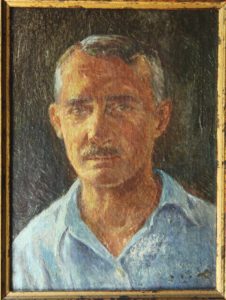
This year being Canada’s 150th birthday, I was pleased to receive “Looking for Grandfather”, an account of an epic motorcycle adventure in 2010 by two B.C. Seniors, Bill Day and cousin Michael Pease. Written by my good friend Bill Day of Hedley (part time), it’s a real life story of their 6 day, 3000 kilometer ride to learn about their mutual grandfather, painter Richard Lindemere. Almost in passing, Bill manages to skillfully weave in fascinating snippets of an earlier time in western Canada.
Bill notes that Grandfather Lindemere had been raised in a privileged environment in London and studied painting in Paris, where he had an apartment on the Champs Elysee. Also, “he spoke beautiful French.” This lavish lifestyle came to a tumultuous end when the family fortune was lost in the great London stock market crash of 1898.
Lindemere returned to England, acquired a very fleet Greyhound and began to gamble in dog racing. The Greyhound brought him some monetary success. Confident of the dog’s speed, he rashly placed a huge bet, for which he had no financial backing, in a particular race. All went well until the animal leapt over a fence to chase the rabbit the promoters used to motivate the dogs.
Unable to pay the gambling debt, at age 24 he fled to Canada. “Like a lot of young middle class Englishmen at that time,” Bill says, “he had dreams of becoming a cowboy, work for which life experiences had not prepared him.”
It was 1904 and only 19 years after the second Riel Rebellion. “Poundmaker, the great political and military leader of the native peoples was still in very recent memory. Gabriel Dumont, Louis Riel’s lieutenant and brilliant military leader of the Metis, was living quietly at his original homestead at Batoche.”
In spite of the sophistication of his life to this time, Richard Lindemere evidently possessed the pluckiness required to adapt to the more rugged western Canada setting. He did become a cowboy and worked as a drover, participating in 3 major cattle drives from 1905 to 1907.
“It was a time,” Bill observes, “when the North West Mounted Police were a huge presence on the prairies, and were generally well regarded by the Aboriginal people.” Lindemere developed life long friendships with Mounties and they appeared in many of his paintings. Three great Chiefs, Poundmaker, Fine Day and Crowfoot captured his admiration and respect, as did Gabriel Dumont. According to Bill, “Grandfather systematically painted the Native and Metis leaders of the time, including Fine Day, who lived until the 1930’s and was Grand Chief of the Saskatchewan Cree.”

Lindemere established a homestead with his brother, “Uncle Bertie”. According to the family it failed, likely because he devoted his time to painting and his brother spent his time whittling.
At this point Bill’s narrative picks up the motorcycle trip. “The final 30 kilometers to Batoche was along the South Saskatchewan River, a step back in time. Family subsistence farms appeared, many with French names, obviously descendants of the original Metis settlers. They were laid out in strip fashion, characteristic of riverine settlements in Quebec.”
Obviously captivated by the political, social and military dynamics of those years, Bill now slips into a disquieting aspect of Canada’s relationship with indigenous people. “Despite superior generalship and brilliant tactics,” he says, “the Metis and Native forces were ultimately overwhelmed by the sheer numbers and fire power (Gatling guns and cannon) of the Canadian troops.”
After days of hard riding Bill and Michael arrived at their ultimate destination, the Saskatchewan Legislature. Here a number of Lindemere’s paintings are hung in the Prince Edward Room. The Security Officer told them the room was booked all day for a cabinet meeting. “We explained our desire to see Grandfather’s paintings and he looked at these 2 old guys in dusty leathers, then told us to wait. Shortly we were informed that the Premier had granted us10 minutes during their lunch break.”
Mesmerized by this segment of family history, they viewed Richard Lindemere’s 1928 painting of the Speaker of the House, commissioned by the Saskatchewan government. There were also 8 paintings of the North West Mounted Police. (Some of Lindemere’s paintings and sketches will be featured on my blogsite this month.)
Bill, age 77 at the time of the trip, says “Six whirlwind days, about 3000 kilometers, flawless machine performance, and we found Grandfather.” Richard Lindemere left a rich legacy for family and Canada!

Hello,
We are trying to research a painting we believe was done by Gladys Lindemere possibly your Grandmother? It is a picture of the coast of Vancouver with Madrona trees in watercolour with oil.
Hello Sheila, I’m not personally related to the Lindemere family. I’ve sent your name and contact information to Bill Day who is the subject of this post and is a grandson of Richard Lindemere. Good luck in your search. If I come across any further information I’ll send it on to you. Art
Fine Day was not a Grand Chief. He was head of the Warrior Society of his band, so would be the Chief in times of War. This did not apply to the “Saskatchewan Cree,” but to his band, The River People Band of the Plains Cree.
Thanks for this clarification, Eden. I’m certainly interested in learning more from you if you would write again.
Art
Hello Eden,
So good to see your name and comment. Much, much appreciated. The painting is a treasured part of our family memorabilia.
Bill Day